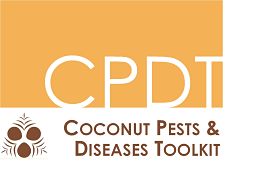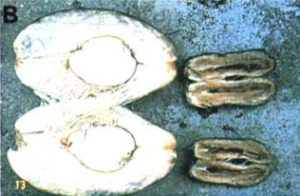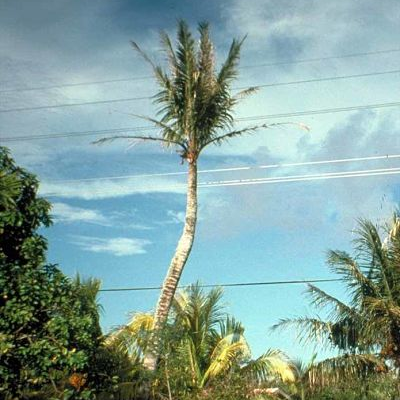Tinangaja
Tinangaja is a considerable disease of coconut in Guam. This is a HIGH risk disease if it should spread elsewhere in the Pacific.
Common name of the diseaseTinangaja |
Scientific name of the cause of the diseaseCoconut tinangaja viroid (CTiVd) |
on this page: Symptoms : Impacts : Distribution : Prevention : Controlling Tinangaja : Information sources and further reading
Tinangaja is a disease caused by a viroid. Viroids are similar to viruses, but are even smaller and more simple in their biology. While viruses are made up of DNA or the very similar molecule RNA**, enclosed in a protein coat, viroids are just much smaller lengths of naked RNA.
Tinangaja is similar to the lethal coconut cadang-cadang disease in the Philippines.
The viroid is too small for detection by the human eye. However molecular testing can be done to confirm the presence of the virus. See the Symptoms section below to identify possible occurrence of the disease on coconut.
It is not certain how the viroid is spread, but mechanical, seed and pollen transmission are possibilities.
**RNA and DNA are molecules (chemical building blocks) known as nucleic acids, and both are used for transmitting genetic information within (and between) living things. Structurally, DNA and RNA molecules are almost identical. However, there are fundamental differences between the two that leads to the molecules having very different functions. A simplified perspective is that plants, animals, fungi and bacteria use only DNA as the template for their genetic make-up. These organisms use different types of RNA to transmit information, usually to make up amino acids, and then proteins. The genetic material of viruses can be DNA or RNA. RNA viruses (and viroids) use RNA as the template for their genetic make-up and for transmitting information.
Symptoms
|
Healthy nuts (left) vs. diseased thin and small nuts with scarring (right) (© Dagmar Hanold and John Randles, Waite Agricultural Research Institute) |
Healthy nuts (left) vs. diseased nuts showing no central kernel (right) (© Dagmar Hanold and John Randles, Waite Agricultural Research Institute) |
|
Tinangaja disease usually appears on mature palms after they have started fruiting. Some of the symptoms can be confused with those of other stresses. Initially, there is a progressive thinning of the crown and a reduction in the size of the nuts. Leaves develop small yellow spots. The nuts will grow thin and small, show scarring and have no central kernel. Full yellowing of leaves will start to occur at later stages of the disease and nut, leaf and flower production will slow. The crown will look thin and battered. The trunk will taper near the crown. Death of the palm will occur up to around 15 years after infection. |
Coconut palm with a thin and battered crown and a tapered trunk (© George Wall, formerly CALS/AES University of Guam) |
Impacts
Tinangaja has a serious impact on Guam's coconut industry. Coconut is not commercially traded by Guam (i.e. copra) but it is important for nutrition and as a cooking oil. Coconut palms are an important component of the landscape and environment in Guam as they act as windbreaks, shade for light intolerant plants and reduce coastal erosion. Coconuts also add value to the tourism and landscaping industry.
The impact of having to replace, or not being able to grow healthy palms is costly to Guam. Reliance on imports of processed coconut for consumption and healthy palms for the landscape greatly affects the well-being of communities and businesses.
The disease may decrease coconut diversity as there is a possibility of only disease-resistant varieties surviving.
Distribution
Please check with your local biosecurity / quarantine or SPC for up-to-date distribution information.
Tinangaja has only been recorded in Guam.
Prevention
Most importantly, the International Guidelines for transfer of coconut germplasm should be strictly followed to prevent pests and diseases being moved to new locations.
The transport of live coconut tissue without regulation will increase the chances of spread especially since it is unknown if the disease is spread through pollen or seed nuts.
In many viroid diseases, the use of non-sanitised cutting and pruning tools is a major cause of spread, so this may be a risk to consider. Some experts have suggested that incidence of the disease is directly related to levels of human activity: people injuring stems with bush knives and similar.
As the disease progresses slowly, inadequate monitoring from the initial signs of symptoms may cause the disease to be missed.
For general information on preventing pests and diseases of coconut, see the Prevention section.
Controlling Tinangaja
Tinangaja takes a long time to progress, and it is not known how the disease is naturally spread. Because of this diagnosis and control are difficult. However, there are clear recommendations that can help reduce the spread of the disease.
Cultural
All equipment used for cutting and pruning coconut should be cleaned to stop the spread of the viroid. An effective treatment for viroids is to soak tools in a 1% solution of sodium hypochlorite for up to one minute. This can be effectively prepared from fresh household bleach products diluted correctly and used the same day. Rinsing the tools with plenty of water is needed to prevent corrosion.
The FAO/IBPGR Technical Guidelines for the Safe Movement of Coconut Germplasm should be followed. The embryos of coconut should be grown in a sterile culture medium when transported.
Infected trees should be removed and destroyed if molecular testing confirms the presence of the disease. When possible, test seedlings to ensure they are healthy and then replant. Areas of Tinangaja should also be identified so seeds are only taken from disease free areas.
Testing for Tinangaja and other viroids in collected pollen from palms, seedlings and embryos is also recommended. If testing resources are unavailable, then transported seeds can be germinated and tested in intermediate quarantine. Testing for viroids is possible, but not easy. Only a few very specialised laboratories are capable of this work. Please contact SPC for further information.
Natural
Javanica Red Dwarf is suggested to be more tolerant than other varieties. If possible, replanting of this variety may help control and reduce the occurrence of disease.
Chemical
There are no chemical treatments for Tinangaja.
Information sources and further reading
PestNet. 2017. Coconut tinangaja. [ONLINE]
Hodgson, Wall, Randles. 1998. Specific Identification of Coconut Tinangaja Viroid for Differential Field Diagnosis of Viroids in Coconut Palm. Phytopathology, 88, 8, 774-781
Plantwise. 2018. Yellow mottle decline (Coconut tinangaja viroid). [ONLINE]
content reviewed by Richard Davis, Northern Australia Quarantine Strategy, Department of Agriculture and Water Resources, July 2018



